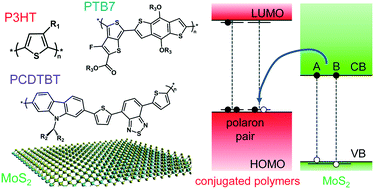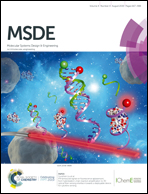Charge transfer dynamics in conjugated polymer/MoS2 organic/2D heterojunctions†
Abstract
Heterojunctions between organic and two-dimensional (2D) semiconductors show promising applications in ultrathin electronic and optoelectronic devices, including field-effect transistors, light-emitting diodes, and photovoltaics. These organic/2D heterojunctions form ideal interfaces due to the lack of dangling bonds at the surfaces of the neat (i.e., individual) materials and their propensity to interact via van der Waals forces. Despite this, organic/2D heterojunction devices have had relatively low quantum efficiencies, suggesting limitations on the charge transport within these devices. Understanding the charge transfer dynamics across organic/2D semiconductor interfaces at fundamental time scales is an important part of overcoming these limitations. In this work, we investigate the photoexcited charge carrier dynamics in organic/2D heterojunctions comprised of large-area monolayer MoS2 and solution-deposited organic semiconducting conjugated polymer thin-films. Using photoluminescence and femtosecond transient absorption spectroscopy, we compare the efficiencies of charge transfer for three different conjugated polymer/MoS2 heterojunctions: P3HT, PCDTBT, and PTB7. We show that electron transfer occurs from MoS2 to P3HT in under 9 ps, and from MoS2 to PCDTBT or PTB7 in under 120 fs. Despite this, we demonstrate that the P3HT/MoS2 heterojunction is the most efficient because the transferred charges have an order-of-magnitude increase in their lifetimes, giving rise to enhanced photoluminescence. This work will help guide designs of future organic/2D heterojunctions using scalable fabrication technologies.

- This article is part of the themed collection: 2D materials: molecular design and engineering perspectives


 Please wait while we load your content...
Please wait while we load your content...